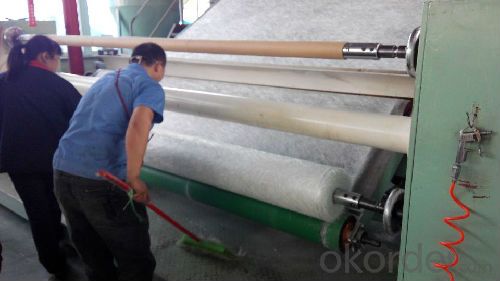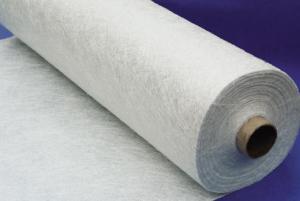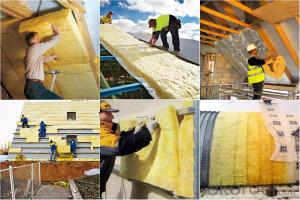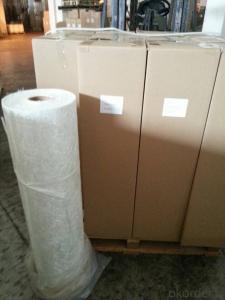Стекловолокно Мат "Московский пятно хорошее качество "
- Loading Port:
- China Main Port
- Payment Terms:
- TT or LC
- Min Order Qty:
- -
- Supply Capability:
- 25000kg kg/month
OKorder Service Pledge
OKorder Financial Service
You Might Also Like
Стекломат эмульсионный
Эмульсионный стекломат производится из Е-стекло ровинга,клиееного эмульсионным вяжущим,обладает хорошей способностью смачивания с полиэфирным,виниловым и эпоксидным смолам.
Продукты из данного стекломата преимущественно перерабатываются методами ручного формования,намотки и прессования, широко применяются для производства разных стеклопластиков,корпусов лодок,автомобильных запчастей и охлаждающих башен.
Мы поставляем стекломат 300г\450г\600г по ширине 1250мм !!!
Основные преимущества
1.Вследствие хорошей целостности достигает более высокого стеклосодержания и коэффициента армирования,чтобы повышает механической прочности стекпластика
2.Данный стекломат отличается хорошей целостностью и формуемкостью,малым выделением летучних веществ в процессе переработки;
3.Отличная гибность подходит к формованию
4.Быстрая и полная смачиваемость в смоле,малая потребность смолы преведут к снижению себестоимости производства,повышению производительности и механических свойств конечных продуктов.
Упаковка:
Стекломат намотан на бумажные патроны.Рулоны заворачиваются пластмассовыми плеками,уложены в бумажные коробки,или заворавиваются крафт-бумагой.Рулон должны положить горизонтально.В транспортировке рулоны могут прямо загружать в котейнеры или с помошью поддонов.
Добро пожаловать посетить наш склад !
Перечисленными свойствами обычно обладают маты, выработанные из нитей из "Е"-стекла, обработанных силановым связующим и склеенных полиэфирным связующим веществом. мы начали строить склады в Москве, Мы являемся государственные предприятия, мировая экономика пятьсот компаний,мы несем ответственность за таможенное оформление и транспортировку, Маты из рубленных нитей "Е" -стекла и Тканые ровинги, Маты из рубленных нитей "Е" -стекла (эмульсия), ширина 1250 мм, вес 42 килограмм в рулоне,
300 грамм /за квадратный метр, 450 грамм /за квадратный метр, 600 грамм /за квадратный метр,
Вы всегда можете пойти в мой склад, чтобы увидеть товары, проданных к вам, вы всегда можете посетить наш склад



- Q:How is fiberglass mat tissue used in the production of storage containers?
- Fiberglass mat tissue is commonly used in the production of storage containers to reinforce and strengthen the structure. It is typically applied as a layer between the layers of resin and fiberglass to improve the container's durability and resistance to cracking or breaking. The fiberglass mat tissue acts as a reinforcement material, providing additional strength and stability to the container, making it more suitable for heavy-duty storage purposes.
- Q:How does the roll diameter of fiberglass mat tissue affect its handling?
- The roll diameter of fiberglass mat tissue affects its handling by influencing its weight, ease of maneuverability, and the amount of material that can be handled at once. A larger roll diameter may be heavier and more challenging to handle, requiring more effort and potentially causing strain. Additionally, a larger roll diameter may limit maneuverability, making it harder to transport or position the material. Conversely, a smaller roll diameter is typically lighter and easier to handle, allowing for more flexibility in moving and manipulating the fiberglass mat tissue.
- Q:Can fiberglass mat tissue be used for mold-making?
- No, fiberglass mat tissue is not typically used for mold-making. Fiberglass mat tissue is a lightweight material made from randomly oriented glass fibers bonded together with a binder. It is commonly used in insulation, construction, and automotive industries for reinforcement purposes. For mold-making, other materials such as silicone, latex, or polyurethane are more commonly used. These materials have the necessary properties to create flexible and accurate molds that can reproduce intricate details. They are also easy to work with and can be poured or brushed onto the original object to create a mold. Fiberglass mat tissue, on the other hand, lacks the flexibility and accuracy required for mold-making. It is not designed to be easily molded into complex shapes or capture fine details. Additionally, it may not provide the desired level of flexibility needed to remove the original object from the mold without causing damage. Therefore, it is recommended to use specific mold-making materials that are specifically designed for this purpose, rather than attempting to use fiberglass mat tissue.
- Q:Does fiberglass mat tissue require any special handling or storage requirements?
- Yes, fiberglass mat tissue does require special handling and storage requirements. It should be stored in a dry, clean, and well-ventilated area to prevent moisture absorption. It should also be kept away from direct sunlight and extreme temperatures to maintain its quality. Additionally, it is important to handle fiberglass mat tissue with care to avoid any damage or injury, as it can be sharp and fragile.
- Q:How is fiberglass mat tissue used in the production of chemical storage tanks?
- Fiberglass mat tissue serves as a reinforcement material in the manufacturing of chemical storage tanks. It is combined with resin to create a composite material that offers strength, durability, and protection against different chemicals. By layering the fiberglass mat tissue within the tank structure, its structural integrity is enhanced, and the risk of leakage is prevented. During the manufacturing process, resin, typically polyester or epoxy, is impregnated into the fiberglass mat tissue to establish a strong bond between the fibers and the matrix. This impregnated mat is then placed on a mold or mandrel and covered with additional layers of resin and mat, resulting in a laminate. The number of layers and thickness can vary based on the desired tank specifications and the chemicals it will store. The combination of fiberglass mat tissue and resin yields outstanding corrosion resistance, making it ideal for storing a wide range of chemicals. Fiberglass is inherently non-reactive and can endure exposure to harsh chemicals, acids, and alkalis without compromising the tank's structural integrity or degrading. Hence, fiberglass mat tissue is the preferred material for chemical storage tanks as it guarantees the safety of stored chemicals and minimizes the risk of leaks or contamination. Moreover, the utilization of fiberglass mat tissue enables the production of tanks with complex shapes and sizes. It can be easily molded and formed into various configurations, providing flexibility in design. This ensures that chemical storage tanks can be tailored to specific requirements and seamlessly integrated into diverse industrial applications. In conclusion, fiberglass mat tissue is indispensable in the manufacturing of chemical storage tanks. It reinforces the tank structure, offers chemical resistance, and facilitates the fabrication of tanks with diverse shapes and sizes. When combined with resin, it creates a durable and corrosion-resistant composite material, ensuring the secure storage of chemicals in a variety of industrial settings.
- Q:What are the different fabric finishes available for fiberglass mat tissue?
- Some of the different fabric finishes available for fiberglass mat tissue include plain weave, twill weave, satin weave, and leno weave. These finishes affect the appearance and texture of the tissue, as well as its strength and durability.
- Q:How does the weight of fiberglass mat tissue affect its performance?
- The weight of fiberglass mat tissue directly affects its performance as a lighter tissue allows for better flexibility and ease of handling, while a heavier tissue provides increased strength and durability.
- Q:Can fiberglass mat tissue be used for insulating metal buildings?
- Yes, fiberglass mat tissue can be used for insulating metal buildings. It is a commonly used insulation material due to its excellent thermal properties and ability to resist heat transfer.
- Q:Is fiberglass mat tissue suitable for oil and gas applications?
- Yes, fiberglass mat tissue is suitable for oil and gas applications. Fiberglass mat tissue is a lightweight, strong, and durable material that can withstand the harsh conditions commonly found in the oil and gas industry. It has excellent resistance to chemicals, including oil and gas, making it an ideal choice for applications such as pipeline insulation, tank lining, and filtration systems. Additionally, fiberglass mat tissue has low moisture absorption, good thermal insulation properties, and can be easily fabricated into different shapes and forms, making it a versatile material for various oil and gas applications.
- Q:Can fiberglass mat tissue be used for composite panel manufacturing?
- Yes, fiberglass mat tissue can be used for composite panel manufacturing. It is a common material choice for reinforcing composite panels due to its high strength, durability, and compatibility with various resin systems. The fiberglass mat tissue provides structural integrity and improved strength-to-weight ratio to the composite panel, making it suitable for a wide range of applications.
1. Manufacturer Overview |
|
|---|---|
| Location | |
| Year Established | |
| Annual Output Value | |
| Main Markets | |
| Company Certifications | |
2. Manufacturer Certificates |
|
|---|---|
| a) Certification Name | |
| Range | |
| Reference | |
| Validity Period | |
3. Manufacturer Capability |
|
|---|---|
| a)Trade Capacity | |
| Nearest Port | |
| Export Percentage | |
| No.of Employees in Trade Department | |
| Language Spoken: | |
| b)Factory Information | |
| Factory Size: | |
| No. of Production Lines | |
| Contract Manufacturing | |
| Product Price Range | |
Send your message to us
Стекловолокно Мат "Московский пятно хорошее качество "
- Loading Port:
- China Main Port
- Payment Terms:
- TT or LC
- Min Order Qty:
- -
- Supply Capability:
- 25000kg kg/month
OKorder Service Pledge
OKorder Financial Service
Similar products
New products
Hot products
Related keywords





























